Student movements in Malaysia have once again taken centre stage in reshaping the political landscape of the country. But after all is said and done, where do we go from here?
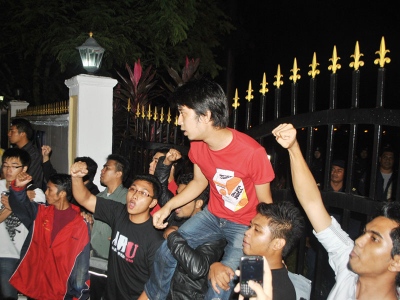
It has been one hell of a ride for the student movement in Malaysia for the past few weeks, starting with the government’s (non-committal) promise to reform and grant political freedom to university students by promising to amend Section 15 of the University & University Colleges Act 1971 but also at the same time appealing the Court of Appeal’s decision in our case to Federal Court.
Most recently, once again, student movements in Malaysia took centre stage as opinions were split in the middle over the actions of one particular student, Adam Adli, in the now legendary yet infamous ‘Flag-gate‘ incident at PWTC. It was a few days later that a notice from his university, Universiti Perguruan Sultan Idris (UPSI), was served to him and informed that he will be put through an internal disciplinary proceeding, just like the ones that we were subjected to in the ‘UKM4’ case a little while ago.
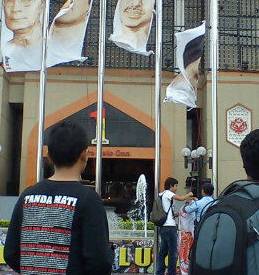
“Flag-gate”
The public’s reaction to Flag-gate saw splits between members of the civil society where some felt that Adam & the students didn’t do anything wrong in wanting to express their dissatisfaction to the administration by lowering a banner/flag bearing Prime Minister Najib Tun Razak’s face, replacing it momentarily with Kumpulan Mahasiswa Menuntut Kebebasan Akademik (BEBAS) flag.
However, there are also members of the civil society, who disagreed with Adam’s actions and labeling it as a ‘tactical & strategic error’ in the students’ campaign for academic freedom, which may have even resulted in turning away fence sitters or supporters of the cause who likened his actions to the analogy of going unto someone else’s private property or homes and messing around with the flower pots and plants. Nothing too serious but it turns people off.
So, there are two sides to a coin here and it has successfully sparked healthy debates on Twitter regarding the actions of Adam Adli, which led further into the discussion of responsibilities and accountability in exercising one’s rights.
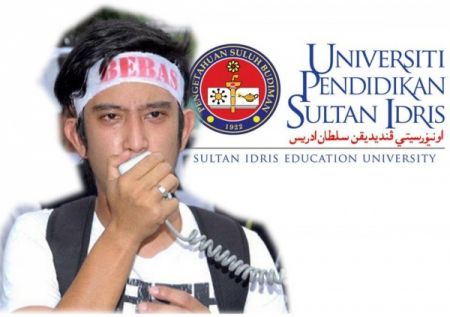
“We are all Adam Adli”
Fast forward to the turn of the new year, roughly 100 students from UPSI, supported by the leadership from Solidariti Mahasiswa Malaysia (SMM) and BEBAS organized a midnight protest at UPSI’s main gate to show support and solidarity for Adam.
However, many Malaysians woke up on the first day of 2012 to news of police brutality and how 2 students suffered serious injuries and were hospitalized and in critical condition. There was a public outrage against police brutality based on early reports from students on the ground on Twitter.
Even so, no one had any further details of what happened in the protest until later in the day, an 8-minute video surfaced on YouTube showing bits & pieces of the protest, from the beginning of the protest to when things begin to get out of hand and finally the arrest of the students by the police and scenes of chaos when Safwan broke into an uncontrollable fit/seizure. I personally think everyone should watch the 8-minute video (here) before forming an opinion on this matter, albeit the messy bits and pieces of footage available.
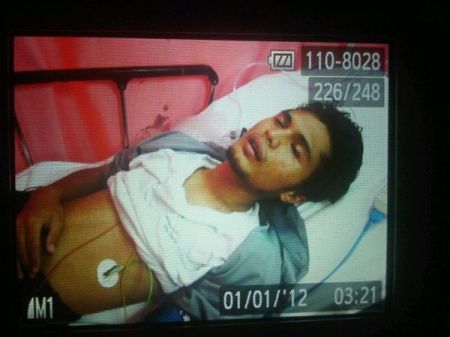
“Police brutality and the evidence of it”
Personally, after watching the video, I don’t see any form of police brutality, such as an officer physically harming and hitting another student with the intention to harm, from the footage. I’m inclined to think that the messy recording and edited 8-minute footage may not have shown all perspectives to the events that happened at UPSI.
Perhaps the students were hit and brutalized by the police. But the video didn’t show it. Perhaps the students caught their injuries when they are being man-handled by the police because they resisted arrest. But neither did the video show anything of that sort. So, for the rest of us who were not there on that day, we didn’t have much to work on to form a rational and informed opinion.
In fact, many chose to reserve their comments until a more complete picture is given and a full inquiry into the allegations is conducted, even though initial reactions on Twitter were overwhelmingly supportive of the students and no one believed the police when they claim that they’re not responsible for the students’ injuries.
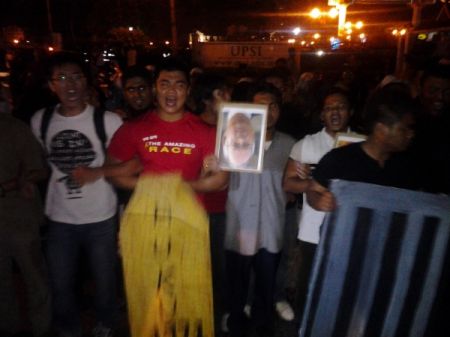
“Two sides of a coin, again”
Early news reports said that one of the victims, Muhammad Safwan Anang, was dying and that he had suffered broken ribs but X-ray films from the hospital have confirmed that no rib was fractured. Even so, the students claimed that the hospital was in cahoots with the police in covering up the injury and they are seeking a second opinion on the matter.
Just like Adam’s flag-gate, the UPSI protest on New Year’s Eve has split public opinion down the middle. There are some who believed that the students were wrong in letting things get out of hand by climbing over university gates and breaking down of the 24-hour clinic’s front door to demand medical attention for Safwan.
There are also some who insisted that regardless of how things may have unfold, the students have unfettered rights in expressing themselves, especially in solidarity with Adam, who is facing unnecessary disciplinary proceedings over the flag-gate incident.
“Taking sides, burning bridges”
However, in this instance, the issue was lost when students and supporters of the cause allow their emotions and partisanship to overshadow the critical debate in this issue. It has become a zero-sum debate where many assumed the position that ‘if you are not with me, then you are against me’.
It is not healthy for the development of democracy when people begin to assign values of right and wrong to individuals, personalities of even political parties instead of looking at the issues rationally from all angles before making up one’s mind about a certain issue.
What happened to the very same political maturity that the students have been working so hard to bridge between political differences to stand-up collectively for fundamental liberties of one another?
Why must we allow ourselves to descend into partisan political debates that alienate one another?
Although I can empathize with what these students are going through (Hell, the four of us were put precisely in that very same position a little less than 2 years ago!), all I’m asking is for them to consider the perception that they are creating through the actions that they have committed to carry out.
Don’t let partisan politics cloud one’s judgment that ultimately does more harm to the cause by turning away fence-sitters and supporters of the cause who stood with us because they believe in the same principles that we fought for.
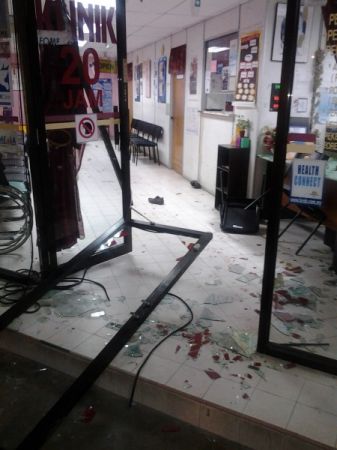
“The Thin Red Line”
There are two fundamental issues here, with regards to the students’ protest at UPSI on New Year’s Eve: 1. The issue of police brutality, and 2. The exercise of the students’ freedom of expression and assembly.
Regarding police brutality, I think much of it has been explained in the previous paragraphs that nothing at the moment seem to suggest any truth in early reports of police brutality on Twitter. Any eye-witness and video footage available at the moment do not give the full picture to the events and how the arrest was carried out.
Secondly, there seem to be a hot debate on whether the students were right or wrong in how they conducted the protest and whether it could’ve provoked the police in responding aggressively to contain the protest. I feel that the students have all the liberty in the world to organize and stage a protest whenever or wherever they wish, for whatever reason or cause they wish to champion.
However, when the rights of others are infringed and their private properties damaged, that’s when a person can no longer lay claim to exercising his or her freedom and liberty. Examples of students angrily rattling the university’s gate demanding it to be opened at midnight, provoking the police and knocking down the glass doors of a private clinic from the recent protest do come to mind.
That is the main reason why I thought some of the actions taken by the movement today have mis-represented the fiery passion of youth in fighting for the values and principles that they believe in.
I had many personal experiences with organizing campaigns of advocacy with many of the leaders within the movements involved and I know they are not the kind of troublemakers that many detractors of the cause have made them out to be. And that is the reason why this article is written, to explain the reason why the entire movement now has been mis-interpreted and mis-represented.
What I hope to achieve is to keep the debate alive and as unpleasant it may be to have to swallow one another’s differences in opinions and views, it is all a positive step towards a maturing democracy.

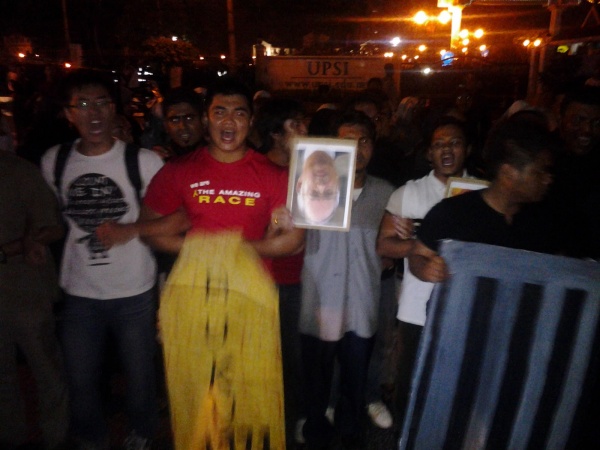
nice post thanks for sharing
You really make it appear really easy along with your presentation but I find this topic to be really something which I think I would by no means understand. It seems too complicated and very wide for me. I’m taking a look forward on your next submit, I will try to get the hold of it!
i'm just wondering why in malaysian student movement there is a lack of participation from ethnic chinese and indian students in any of the student action? from my observation most of the student actions whether in the form of demonstration, street protest, picket, dialogue, debates, talk and forum mostly participated by malay students. in the case of protest in front of upsi or najib's flag incident or other student's protest i hardly see any chinese and indian students involved in those protest. why is student movement in malaysia mainly participated by the malay students even though the issues that the students carry are generally universal issues of human rights and democracy? are chinese and indian students are more pragmatic or more apathetic or more fearful of the risk or simply because they don't care about student politics and student rights?
Dear 'Hussain ibn Ali',
Thank you very much for your comments and views on this matter, I'm even more humbled that you have correctly pointed out all of my views on matters and events concerning student activism in the past. And i must say, my views on those matters and especially matters concerning students remain the same as they were, regardless of my vocation or my view on politics today.
I also need to correct you that the article did not come to a conclusion whether the police was being violent or not. What was pointed out is the limited perspective that we have from that 8-min video and we should reserve our judgment and condemnations until we get a fuller picture. Again, all forms of police brutality and use of excessive force must be condemned.
The breaking of the clinic's door carries no parallel to the glass door incident at UPM, for a few reason:
1. The students involved in UPM glass door breaking incident were on their own campus, not out in the streets and the clinic's glass door that was smashed is on private property
2. In the UPM incident, students were 'kettled' into such a small space along with the police and university security officials, so anything can happen. However, at the UPSI protest, students themselves said that they broke down the door to demand medical attention for Safwan, guy who's seizure acted up in the middle of all these. And even so, there are many versions of the story floating around, which prompted only one question on everyone's mind: Who's telling the truth? What actually happened?
It's rather disappointing that you jumped the gun and concluded based on what you think you know that one should sink to personal attacks. No need to explain in that area, I suppose.
All I can say is this: Please don't jump into conclusions and miss the point and the message of the article. Cheers and do continue to support the students' efforts to abolish UUCA!
In the service of His Supreme Eminenceness,
King Chai
MCA has soften him up i see. the once feared WKC has become just another desperate moderate trying to do some PR job with not much resources. not even being there n not even talking to any of the participants, he goes to conclude that 'there was no violence' when he knows for a fact how violent the police can become, as per his experience when the FRU came into UKM while he was contesting for Pro-Mahasiswa in UKM. not even knowing the circumstances, he accuses the students of trespassing onto private property thus damaging the front glass door. forgetting how he defended Pro-M UPM when it too lost its glass door to provocation by the police.
this here my friends, is a perfect example of how a person fails at staying on with the fight, easily influenced by mere ideals and forgetting his roots. no better than Hasan Ali.
so now what? leave everything behind and kow tow to your new political masters huh WKC? hmmph
Well written KC!!